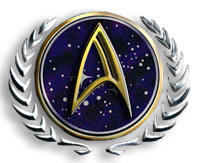New Dublin
-----
Home |
Star Fleet Library |
BuPers |
SF Engineering |
SF Intelligence |
SF JAG |
SF Marine Corps |
SF Medical |
SF Records |
SF Sciences
UFP Dept. of Colonial Affairs |
UFP Educational, Scientific and Cultural Org.

Official UFPDOCA Colony Entry: New Dublin
- Colony Name: New Dublin
- Creator: D'Maris Coffman
(LT Roger McGuinn, CWO4 Brian McGuinn, 1LT Sean Murphy)
GEOGRAPHY
- System/Location: Delta Omicron II
- Distance to Nearest Starbase: 3 weeks to Outpost 18
- Planet Classification: Class M
- Satellites/Space Stations: No natural satellites (proximity to sun); assorted geocentric communications and observation satellites
- Land/Water Ratio: 35/65
- Climate Controlled: Limited (see below)
- Native Sentient Life: None
COLONY INFORMATION
- Colony Age (approximate): 2165 [Founded], 2293 [Federation Colonial Status Recognized]
- Population (approximate): 14 000 000 (800 000 transient)
- Species Present: 95% Human (5% assorted, many transient)
- Colony Status: UFP Colony, Full membership
- Government: Parliamentary Democracy (w/ strong theocratic presence of Roman Catholic Church)
- Major Cities/Settlements: New Dublin, New Cork, New Glasgow, etc.
History
Established by 'lost colonists' from the 'Argyll,' a sleeper ship which launched from Earth with the Jedburgh, Edinburgh, Glascow, and Orkney in the mid twenty-first century.
Unlike the colonists from the other ships, the majority of the 'Argyll' sleepers consisted of a group of separatist Irishmen who had booked passage with the venture. The remainder were mostly lowland Scots-Irish.
The 'Argyll,' along with the other four sleeper ships, encountered an unstable wormhole. System malfunctions interrupted communications with other vessels. When the 'Argyll' emerged, there was no sign of the other ships (which Star Fleet later discovered were thrown considerably further coreward--see New Aberdeen.)
The nearest suitable Class M prospect was the second planet of Delta Omicron, an upper range main sequence star. Proximity to the star precludes natural satellites. Uncontrolled climate was more volatile than that of pre-weather monitoring Terra.
The crippled 'Argyll' limped to Delta Omicron II, the planet they would later rename 'New Dublin.' The Irish majority settled in the northern polar regions, the Scots-Irish minority establishing a much smaller outpost in southern hemisphere. Equatorial regions were considered inhospitable, as surface temperatures during daylight hours averaged fifty degrees centigrade in the tropics.
In 2280, New Dublin was discovered by the USS HOOD on a routine exploratory mission. Both the Irish and Scots-Irish populations welcomed technological upgrades including weather monitoring equipment which would serve to make more of the planet inhabitable.
The Federation agreed to bring New Dublin back into the fold, but not before suitable political progress was made. Over the first century or so of the colony's history, the two settlements had grown distant. Federation authorities were adamant about adequate representation of the minority Scots-Irish contingent in the parliamentarty process.
2292 saw a settlement to this question, 2293 brought formal recognition a Federation colony and the much sought after transfer of technology. The next fifty years also saw a substantial influx of new colonists, bringing the population from a mere 2 million to nearly 10 million. Many of these were again Irish nationalists (or at least admirers of Irish culture), further marginalizing the Scots-Irish minority.
Weather monitoring, while hardly as thorough as that on most Federation planets, is sufficient to make nearly eighty-five percent of the land inhabitable, the remainder considered 'wastes.'
The 24th century brought an economic boom in construction, extractive industries, and tourism. Predictably, the principle beneficiaries of such economic growth were the relative newcomers, widening the socio-economic gap caused by disparities in education, familiarity with new technologies, and relative financial resources.
Nevertheless, political power still rests primarily with the descendants of the original Irish colonists, the Scots-Irish minority holding a 'swing vote' in parliament.
The last forty years have seen limited urban violence, a decline in the standard of living in the older cities, and generalized rapid economic growth in the newer areas.
While having no space defense force of their own, the government of New Dublin does have ground forces, functioning both as the police and as peacekeepers. The planet has always been responsible for its internal security never requiring nor requesting assistance from Star Fleet. A few personnel have done tours as exchange officers with the Star Fleet Marine Corps, fewer still electing not to return.
Otherwise, the Federation Space Cadet Corps has a presence on New Dublin yielding a number of enlistees every year. Unsatisfactory educational standards in the colony itself produce few suitable candidates for Star Fleet Academy absent significant remedial work.
Economy
Latinum based economy. Construction, extractive industries, tourism, agriculture are the major sectors. Anchor Holdings (Terran based) established an early presence on New Dublin and conducts the majority of mining. A few offwordlers own independent operations, particularly in the southern hemisphere.
Class structure and income distribution typical of early twentieth century industrialized countries. Social programs limited; economic practices largely unregulated except insofar as they offend the expectations of the Roman Catholic Church.
Tech Level
Varies. Mid 22nd to Late 24th. (See above)
Culture
Predominantly Irish, lowland Scots-Irish minority in southern hemisphere. Roman Catholic Church very strong. Some relative newcomers belong to reformed Catholic parishes, but they represent a minority, while sizable.
Notes
Popular tourist destination for Terran enthusiasts of Irish culture. Impressive selection of Irish pubs, folk music, dancing, etc. Very active federally funded arts and cultural council.
Merchant marine traffic common, favorite port of call. Adequate facilities for refueling and refit due to presence of Space Cadet Command and merchant traffic. Star Fleet vessels are discouraged from giving liberty, however, due to periodic urban violence and concern in some quarters that Star Fleet may attempt to insert itself in internal security concerns. Individual Star Fleet personnel visiting on their own have never encountered problems.